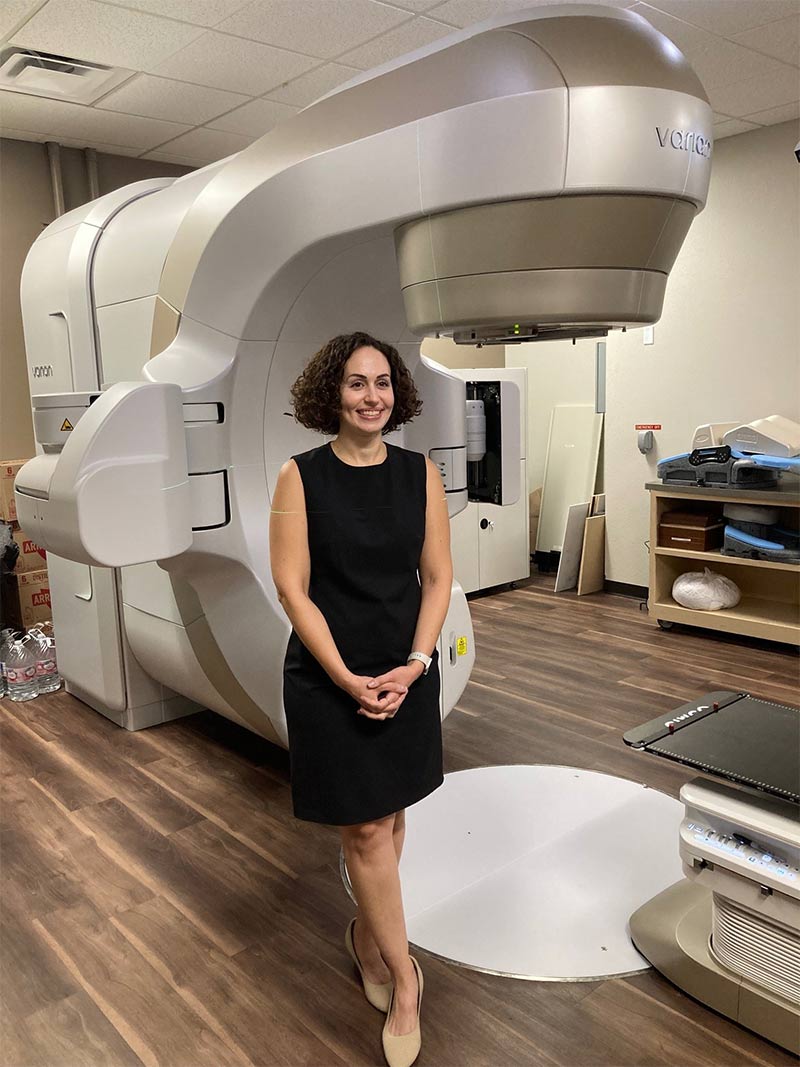September is Gynecologic Cancer Awareness Month. In the spirit of raising awareness and providing education on these cancers, we’ve invited Sarah Kilic, MD, one of the newest members of our radiation oncology team, to share some knowledge.
Dr. Kilic has an extensive background in the research and delivery of treatments for gynecological cancer. She has authored over 30 publications in various medical journals, including JCO Oncology Practice and the International Journal of Radiation Oncology, Biology, Physics. She has also published several book chapters and presented her research at multiple oncology conferences. We asked her a few specific questions about the prevention and treatment of gynecologic cancers.
Having a BRCA gene mutation raises a woman’s lifetime risk of developing ovarian cancer as well as her risk of developing breast cancer. Dr. Kilic gives the numbers: “Biological females with a BRCA1 mutation have about a 40 to 50 percent lifetime risk of developing ovarian cancer. Those with a BRCA2 mutation have about a 10 to 30 percent lifetime risk of developing ovarian cancer.”
In contrast, a woman’s lifetime probability of developing ovarian cancer in the general population is 1.28 percent, or 1 in 78.
Preventing Gynecological Cancer
With this knowledge in place, should everyone be getting tested for BRCA mutations?
Dr. Kilic explains that evidence-based criteria exist for who should get genetic testing for hereditary breast and ovarian cancers. Some of these criteria include a strong family history of breast and/or ovarian cancer, anyone with a personal history of ovarian cancer, certain people with a personal history of breast cancer with less common features (such as being diagnosed at a young age or having triple negative breast cancer), or people of Ashkenazi or Eastern European Jewish descent with a family history of breast or ovarian cancer.
“Patients should never hesitate to ask their physician if they meet criteria for genetic testing,” Dr. Kilic advises. “If their physician is unsure, a great resource is referring the patient to a genetic counselor.”
A genetic counselor will take a detailed personal and family history to determine whether or not you meet criteria for genetic testing. We offer genetic testing and counseling services here at Arizona Oncology to anyone, not just our patients and their families.
“Regardless of your personal or family history,” Dr. Kilic adds, “it’s never a bad idea to ask your physician how you can lower your personal risk of cancer. For the average woman, there are not many well-studied ways to prevent ovarian cancer. However, other gynecologic cancers can be prevented. Most notably, cervical cancers are most commonly caused by infection with the human papillomavirus (HPV), which is a sexually transmitted infection (STI), and therefore, interventions that prevent cervical cancer include using barrier protection during intercourse, receiving regular cervical cancer screening (like Pap smears, which can detect pre-cancer lesions before they progress to cancer), and receiving the HPV vaccine.”
Treating Gynecological Cancer with Radiation Therapy
As a radiation oncologist, Dr. Kilic treats gynecological cancers regularly in her patients, using both external beam radiation therapy (EBRT) and internal radiation therapy (brachytherapy). She talks a little bit about what that looks like.
Uterine cancer: “For cancers of the uterus, radiation therapy is often used after surgery to remove the uterus, to further decrease the risk of cancer recurrence,” Dr. Kilic explains. “In some cases of postoperative radiation for uterine cancer, radiation therapy is delivered externally, by pointing sculpted beams of radiation at the pelvis. In other cases, radiation therapy is delivered internally, by temporarily placing a radiation source inside the patient (brachytherapy), to deliver very high doses of radiation to the target in the pelvis while minimizing the dose of radiation to the surrounding normal organs.”
Cervical cancer: For cervical cancers, patients with all but the earliest stages of this cancer usually do not undergo surgery at all, Dr. Kilic explains. Instead, radiation and chemotherapy are used together to eradicate the cancer. “In these cases, patients usually undergo several weeks of external radiation treatments, followed by a few brachytherapy treatments, to deliver an even higher radiation dose to the tumor and further decrease its risk of recurrence.”
Vaginal and Vulvar cancer: There is a role of radiation in the treatment of vaginal and vulvar cancers as well. Radiation therapy can be used alone or in combination with chemotherapy or surgery, depending on the stage and type of cancer.
Ovarian cancer: This cancer is usually treated with a combination of surgery and chemotherapy. Radiation therapy is not a common treatment for ovarian cancer, but it is sometimes used in certain situations. For example, radiation therapy can be used to treat areas where the cancer has spread, such as the brain or spinal cord.
How safe and effective are radiation treatments? Dr. Kilic replies, “Patients should know that both external beam radiation therapy and brachytherapy have been well-studied for decades and have an excellent track record of safety and efficacy for gynecologic cancers.”
For patients who are to receive brachytherapy, she urges them to feel empowered to ask their physicians what brachytherapy implements will be used and what they can expect during the procedure, if this has not already been discussed. “I always offer my patients to see what the implement looks like before the procedure, and I talk through each step of the procedure in detail, so they can be prepared for what to expect,” she says.
Symptoms of Gynecological Cancer
It is important to consult your doctor about your individual risk and to follow the recommended screening guidelines for gynecologic cancer prevention and early detection. Moreover, you should report any of the following symptoms to your doctor as soon as possible:
Signs of Cervical Cancer
- Bleeding after intercourse
- Excessive discharge and abnormal bleeding between periods
- Vaginal odor
- Pain
Signs of Uterine Cancer (also called Endometrial Cancer)
- Abnormal vaginal bleeding, such as bleeding between periods, after menopause, or after sexual intercourse.
- Abnormal vaginal discharge, such as watery, pink, or blood-tinged discharge.
- Pelvic pain or pressure, especially in the lower abdomen.
- Pain during sexual intercourse or urination.
- A lump or mass in the vagina or uterus.
- Weight loss or loss of appetite.
- Bloating, urinary urgency, or abdominal pain
Signs of Ovarian Cancer (on a daily or almost daily basis for 2 weeks or more)
- Abdominal bloating or swelling
- Feeling full quickly or having trouble eating
- Weight loss
- Pelvic or abdominal pain
- Changes in bowel or bladder habits, such as constipation or frequent urination
- Abnormal vaginal bleeding or discharge
- Fatigue
- Back pain
- Shortness of breath
- Bloating, urinary urgency, or abdominal pain (in case of ovarian cancer spread)
Signs of Vaginal Cancer
- Unusual vaginal bleeding (between periods, after intercourse, new postmenopausal bleeding)
- Pain (vaginal, vulvar, lower abdominal/pelvic, back or flank)
- Problems with urination or bowel movements
- Watery discharge
- Lump or mass in the vagina
Signs of Vulvar Cancer
- Persistent itching, pain, or tenderness in the vulva
- Abnormal bleeding or discharge from the vagina
- Skin changes, such as color changes, thickening, or wart-like bumps
- A lump, ulcer, or open sore on the vulva
Should you have any questions or concerns, reach out to the closest Arizona Oncology facility near you.



